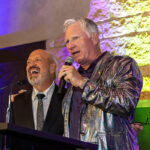Table Read
Author Toni Tipton-Martin strikes up a conversation about food, race, and love.
Dedicated “for us all,” there is a message for everyone in The Jemima Code: Two Centuries of African-American Cookbooks, a book that explores and celebrates the contributions of African-American women—and a few men—to American cuisine. Written by food writer and cookbook author Toni Tipton-Martin and published by UT Press, the book won this year’s James Beard Award for Reference and Scholarship—the culinary industry’s equivalent of a Pulitzer—and the American Librarian Association named it one of the best books published by university presses last year. Tipton-Martin, who also previously partnered with UT Elementary to teach kids about healthy eating, spoke with the Alcalde about why the book resonates.
Alcalde: Congratulations on the awards. What has this recognition signified to you?
Toni Tipton-Martin: I see the James Beard Award and other accolades as indications that the industry is broadening its interest and respect for new voices representing Southern and American cooking. There is a debate in the food world about appropriations and who created what first. I’m not interested in tearing apart a history that is so tightly woven between the black women and the white women who were in the kitchen together. What I am interested in is creating an opportunity for us to have a seat at the table and for our voices to be heard. This doesn’t require the unraveling of someone else’s history, or removing a seat. It simply means that we need to all squeeze in and make more room.
 More books, blogs, and restaurants are popping up that celebrate African-American cooking, like The Cecil in Harlem and Afro-Vegan by Bryant Terry. How does The Jemima Code fit into this larger dialogue?
More books, blogs, and restaurants are popping up that celebrate African-American cooking, like The Cecil in Harlem and Afro-Vegan by Bryant Terry. How does The Jemima Code fit into this larger dialogue?
Now there are more voices contributing to the conversation. With the rise of social media, young people are tracing, exploring, and sharing their history and are no longer bound by the limitations of what a publisher will publish or what a newspaper will interview them about. That said, the authors featured in The Jemima Code have been doing this for years. In 1948, the editor of Ebony magazine gathered recipes from 1,000 middle-class readers to prove that urban poverty and the rural South didn’t exclusively define the African-American culinary experience.
Ten years later, the National Council of Negro Women, an advocacy group in Washington, D.C., had the same motive. The fact that these new voices are now conspicuous is influenced by the fact that they have a platform that those who came before didn’t have.
In the book you write: “And they also salved wounds, nurtured spirits, and imparted wisdom over steaming plates of nourishment.” In an era of fast food and dieting, have we lost some of this connection between food and love?
As we move away from this idea that one cooks as the expression of the heart, it becomes something you just do every day at five o’clock, or it’s this elaborate practice of creating architectural food that lacks the warmth of someone who stood in the kitchen, stripped all of the corn off the cob for you, and then milked that cob to make sure you got every ounce of nutrition out of it.
In the chapter on domestic servants in The Jemima Code, these women had to not only put a hot meal on the table for their employers, but in their own homes, too. They were working women who were also raising children. Yet there are descendants of these women who describe with great love and affection the meals that were made for them, saying, “We didn’t even realize we were poor.” These women could have easily gotten frustrated, given up, and thrown food on the plate, but they didn’t.
Where do you see reviving cultural heritage fitting into the dialogue about how to improve health and the way we eat?
I believe that when individuals are healthy in body, spirit, and mind, they create a healthier community, which leads to a healthier world. We all get so caught up in the business of our day and we don’t think we have time for cooking. It didn’t take anything for an ancestor to take a sweet potato, stick it in a fire, and wait for it to roast. We can do the same thing.
The foods on the list of the healthiest things that you can eat are associated with the traditional African-American diet—dark leafy greens, sweet potatoes, whole grains, very little meat, watermelon—foods that we have been propagandized into avoiding so that we will consume the fast foods that are put in our communities.
I’m trying to get people to also see women and men featured in The Jemima Code as sources of healthier living. There is a mental health component to restoring our pride in our community, but the book also speaks to the physical aspect of health, too.
Photo by Naomi Logan Richard


















No comments
Be the first one to leave a comment.